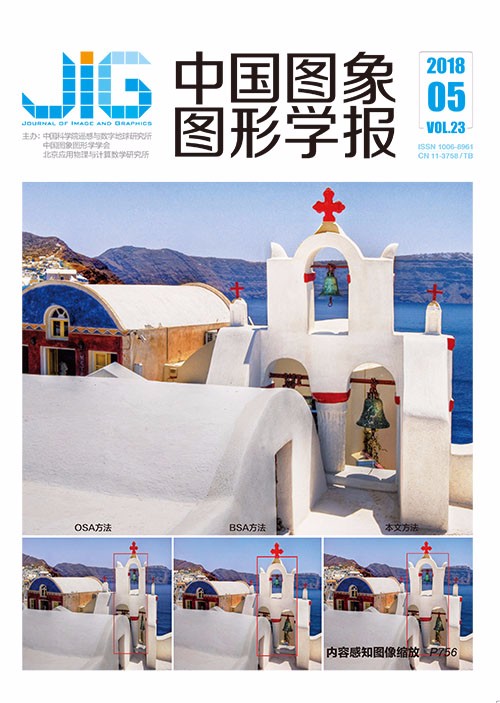
基于弹簧变形模型的图像缩放方法
谷香丽1, 迟静1,2, 张彩明1,2,3(1.山东财经大学计算机科学与技术学院, 济南 250014;2.山东省数字媒体技术重点实验室, 济南 250014;3.山东大学计算机科学与技术学院, 济南 250101) 摘 要
目的 随着显示设备分辨率和纵横比的多样化,内容感知图像缩放技术逐渐成为图像处理领域新的研究热点之一,为了既能实现图像有效缩放,又能较好保持图像主体区域的几何结构完整,提出一种基于弹簧近似的内容感知图像缩放方法。方法 首先,为控制图像缩放,对输入图像进行显著性检测和特征直线检测;其次,在图像上构建一个平面三角网格,视三角网格的每一条边为一根弹簧,则整个三角网格构成一个弹簧系统,可利用该弹簧系统的变形实现图像缩放,其中,根据每根弹簧所在图像区域的显著度设置弹簧的弹性系数,该系数可在缩放时有效保持图像的主体区域,避免主体内容缩放不均匀或变形;然后,以图像直线特征保持为约束,构造用于约束弹簧系统变形的目标函数;最后,利用纹理贴图技术把弹簧系统每个三角形对应的图像贴回弹簧系统,得到缩放后的目标图像。结果 为证明本文方法的有效性,对大量图像进行多比例缩放测试,并与现有方法进行比较。在同比例缩放下,本文方法可以更好地保持图像中的主体区域,以及特征直线,使放缩后的图像整体具有更好的视觉效果。本文方法的计算时间小于0.19 s,时间成本与现有方法大致相同。结论 基于弹簧系统的内容感知图像缩放方法,通过弹簧系统变形带动网格变形进而实现图像缩放,与现有的内容感知图像缩放方法相比,本文方法所处理的图像视觉效果更好,实验结果表明,本文方法能够更有效、快速地处理各种图像的内容感知缩放。
关键词
Image scaling based on the spring deformation model
Gu Xiangli1, Chi Jing1,2, Zhang Caiming1,2,3(1.School of Computer Science & Technology, Shandong University of Finance and Economics, Jinan 250014, China;2.Shandong Provincial Key Laboratory of Digital Media Technology, Jinan 250014, China;3.Department of Computer Science & Technology, Shandong University, Jinan 250101, China) Abstract
Objective With the emergence of a large number of diverse and versatile display devices, the size of images must be adjusted appropriately with different resolutions and aspect ratios before displaying them on the devices. Content-aware image scaling technology has gradually become the focus of new research in the field of image processing, which resizes an image such that the prominent feature of the image is intact and the homogenous content is distorted as little as possible. This study proposes a novel content-aware image scaling method based on spring analogy to achieve image scaling effectively and have better capability to prevent the distortion of significant objects and feature lines. Method We resize an image by representing an image as a triangular mesh in 2D space and viewing each triangle edge as a spring. By deforming the spring system, we can implicitly retarget the image to its new size. First, for the input image, we use the saliency detection algorithm to generate the saliency of each pixel and employ the Hough transformation to detect the feature lines. Second, Delaunay triangulation of the sampling nodes of the image is employed to build a 2D triangular mesh on the input image to build a spring system for the image. A spring system on the mesh is constructed. Each edge of the mesh is considered a segment of an elastic spring, and the length of the edge is used as the initial equilibrium length of the spring. Once the boundary locations are changed by an external force, the interior will expand or contract to reach a new balance of the spring system, leading to a deformed mesh. Then, the image zoom is implemented through optimized deformation of the spring system. Furthermore, we assign a stiffness value to each spring segment to constrain its deformation in the balance of the spring system. Obviously, a high saliency of the image area is corresponds to great stiffness of the segments in the area and small distortion of the segments. Thus, we propose a new measure for spring stiffness, which uses image saliency to compute the elastic coefficient. The coefficient can effectively avoid the main content of inhomogeneous deformation. Finally, the objective function for constraining the deformation of the spring system is constructed by keeping the image linear features as constraints. We map the input image onto the deformed mesh to obtain the final resized image by using the trilinear interpolation method. Result Extensive experiments and comparisons with other state-of-the-art methods (i.e., seam carving, quadratic programming, object size adjustment, shape-preserving approach, and methods based on spring analogy) show that our algorithm can better maintain the main region of the image and the feature line, and the scaled image has a better visual effect as a whole. The calculation time of the proposed method is less than 0.19 s, which is approximately the same as that of the existing method. Conclusion An image scaling method based on spring analogy is proposed to achieve image zooming. Extensive experiments show that, compared with the existing content-aware image scaling approaches, our method has better visual effects and better ability to prevent the distortion of significant objects and feature lines
Keywords
|



 中国图象图形学报 │ 京ICP备05080539号-4 │ 本系统由
中国图象图形学报 │ 京ICP备05080539号-4 │ 本系统由